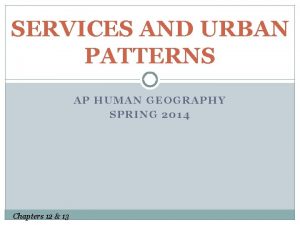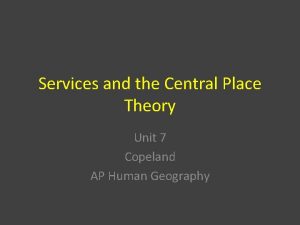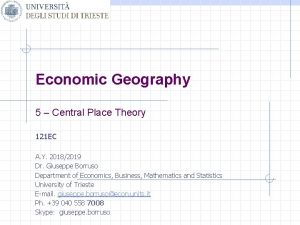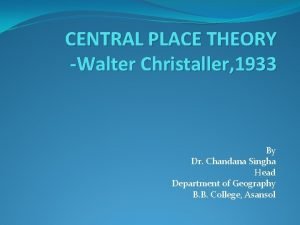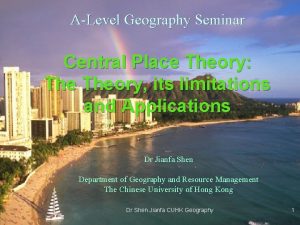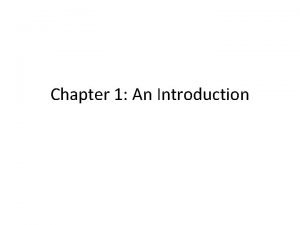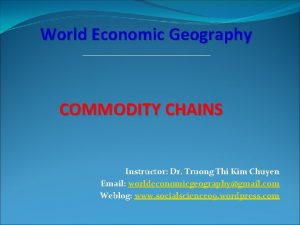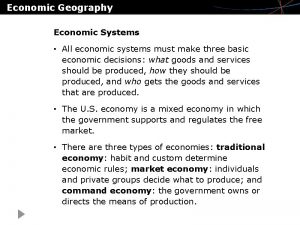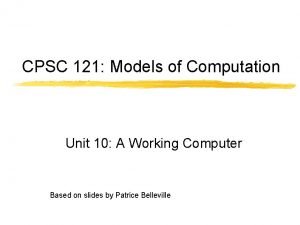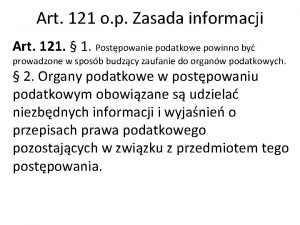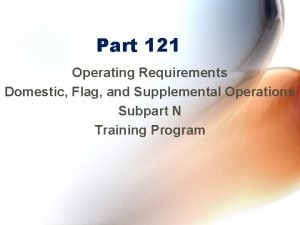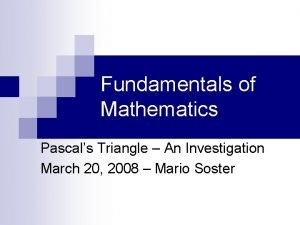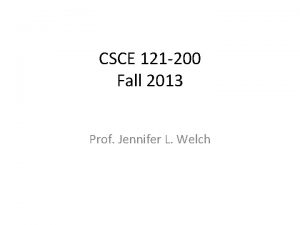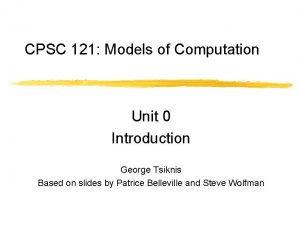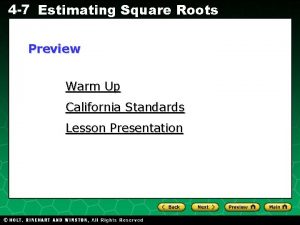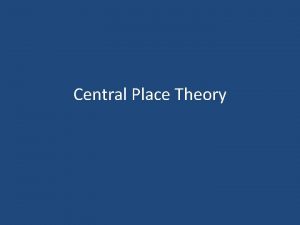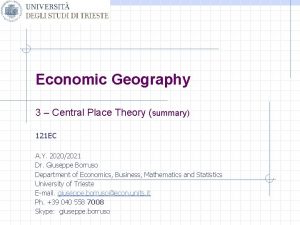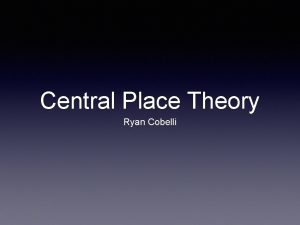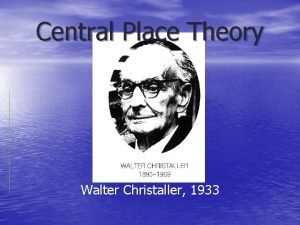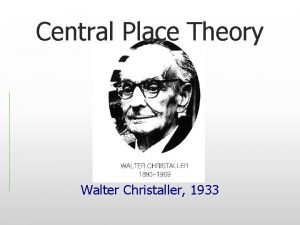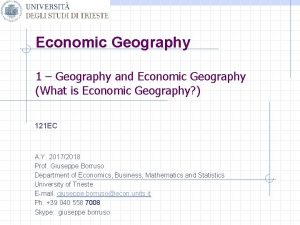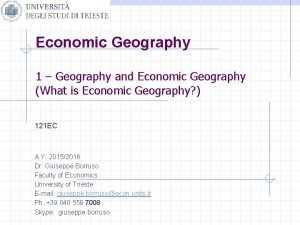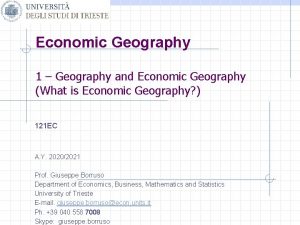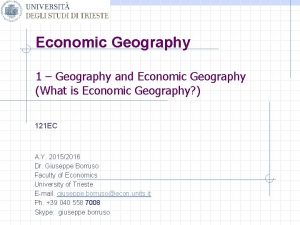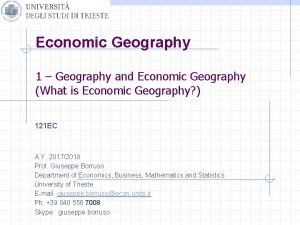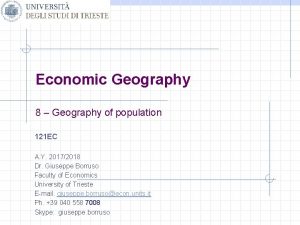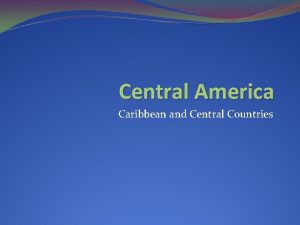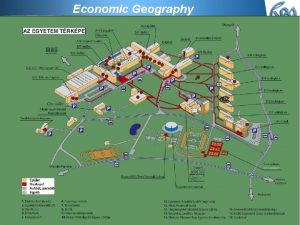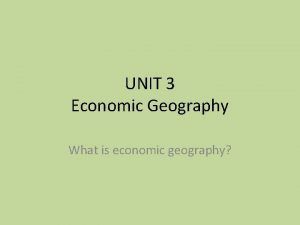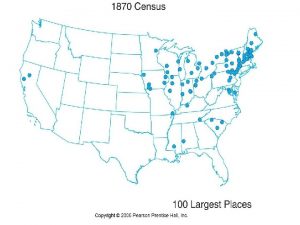Economic Geography 5 Central Place Theory 121 EC

















































- Slides: 49

Economic Geography 5 – Central Place Theory 121 EC A. Y. 2018/2019 Dr. Giuseppe Borruso Department of Economics, Business, Mathematics and Statistics University of Trieste E-mail. giuseppe. borruso@econ. units. it Ph. +39 040 558 7008 Skype: giuseppe. borruso

Learning Objectives w In this lesson we will: n n Revise the assumptions of location in a simplified economic landscape Present Christaller’s central place theory w Define a central place; w Observe the hierarchical organization of places n Understand (once again!) the importance of some kinds of distance in the (business & economic) geographical reasoning.

Topics 1. Location theories: 1. 2. Spatial organization of Agriculture Market and location of services 1. Christaller’s central place theory 2. Loesch & Isard’s theories 3. 4. The location of industries Human settlements => 2. Retail and transport Geography 3. Geodemographics – GIS & Retail Geography

Location in a simplified economic landscape

Simplifying assumptions: the initial constraints of the model w The complexities of the real world are simplified in the model by the use of two sets of assumptions: n n w The first is concerned with the nature of the land surface in the model region The second is concerned with the people who inhabit it Initial constraints: 1. The land surface is an unbounded plain which is homogeneous in all respects: a. b. c. 2. The surface is perfectly flat with no barriers to movement. Movement is therefore possible in all directions. Transport costs are proportional to distance and there is a single uniform transport system. Physical resources are evenly distributed, that is, soils are of equal fertility throughout, raw materials are ubiquitous. The population living on the plain has the following characteristics: a. b. c. An even spatial distribution. Identical incomes, demand schedules, and propensities to consume Both producers and consumers have perfect knowledge and act perfectly rationally with respect to this knowledge. They are able, therefore, to behave in an optimum fashion. a. b. As producers they are assumed to seek a single goal – the maximization of profits As consumers they seek to minimize their outlays in meeting their consumption needs

Location of central places w w w Walter Christaller The German geographer Walter Christaller introduced central-place theory in his book entitled Central Places in Southern Germany (1933). The primary purpose of a settlement or market town, according to central-place theory, is the provision of goods and services for the surrounding market area. Such towns are centrally located and may be called central places. Settlements that provide more goods and services than do other places are called higher-order central places. Lower-order central places have small market areas and provide goods and services that are purchased more frequently than higher-order goods and services. Higher-order places are more widely distributed and fewer in number than lowerorder places. Christaller’s theory assumes that central places are distributed over a uniform plane of constant population density and purchasing power. Movement across the plane is uniformly easy in any direction, transportation costs vary linearly, and consumers act rationally to minimize transportation costs by visiting the nearest location offering the desired good or service. The determining factor in the location of any central place is the threshold, which comprises the smallest market area necessary for the goods and services to be economically viable. Once a threshold has been established, the central place will seek to expand its market area until the range—i. e. , the maximum distance consumers will travel to purchase goods and services—is reached. Since threshold and range define the market area of a central place, market areas for a group of central places offering the same order of goods and services will each extend an equal distance in all directions in circular fashion. https: //www. britannica. com/topic/central-place-theory#ref 155353

Location of central places w Central place = a place whose prime function is the provision of a wide range of goods and services to a dispersed population around it. w How such centre would be located? n n 1 individual member of the evenly distributed population who decides to produce a good over and above his own needs. Whethere would be sufficient returns from the sale of the good to neighbours to cover the producer’s additional costs and to provide him with a reasonable profit. The minimum level of demand required to ensure this would be threshold value for the good in question Unless such a threshold condition were met it would not be produced for sale =>

Location of central places w w => The quantity of the good that a customer will be prepared to buy depends, other thing being equal, on the actual price he is called upon to pay for it In a simplified economical space, since everything else has been constrained, the price to customer varies only with the distance from the point of production. The further he/she is from this point, the less he will consume. In general terms, the greater the distance from the production point the higher the price of the good and the smaller the quantity of the good demanded by prospective customers

Central place theory w Results: n n Regular network of centres with a fixed ratio between those belonging to a given hierarchical order All the others located at a computable theoretical distance from each other Circular area around each centre (hexagon in case of a spatially exhaustive market) Each supply place is related to: w A demand cone w The limit of the cone is the range = maximum distance a consumer is willing to travel to reach the final good/service w A threshold = minimum volume of demand necessary to keep production and distribution economically viable

The spatial organization of market Spatial range of demand Price paid by the consumer: Price of the good + transport cost => The final effective price paid is a linear function of distance d (as distance increases, also the effective price paid by the consumer does so)

The spatial organization of market Spatial range of demand Prices/ costs Theorem 1: the real price is a linear function of distance C P’ P C’ O D the real price is formed by: èthe good’s price at the marketplace èPlus a variable component depending on the transport cost a consumer will pay to reach the market D’ O = place of supply OP’ = maximum price the consumer is willing to pay (including distance’s costs) OP = product’s price OC’ a OD’ = range of the market (circular market centred in O)

Price (distance) The spatial organization of market Spatial range of demand w We can recall the law of A p 1 B p 2 quantity q 1 q 2 demand, where price and quantity are inversely related. w As price decreases, the demanded quantity increases and vice versa. w As price (Theorem 1) can be considered as a function of distance, we can assume that quantity (= demand for a good) varies inversely with distance. w The demand curve can therefore be modified: n n Substituting price with distance; Putting it into space! w That means ‘rotating the axes’ w (see next graph)

The spatial organization of market Hypothetical demand curve for a good Quantity (demand) Theorem 2: the quantity demanded is a linear inverse function of distance w The overall quantity demanded by consumers will be maximum at the market place /place of production w And will decrease as distance increases as the effective price paid by customers will increase - compare points A and B in the previous graph Range of the good / service Price (distance)

The spatial organization of market Hypothetical demand cone for a good w As population is evenly distributed and movement is unrestricted, the demand for a good can be visualized as a cone produced rotating the demand function in two axis. Spatial variation in demand for the good is expressed as a conical surface with the highest point centred on the point of production L and sloping evenly in all directions to the perimeter at d D Quantity w L w w The circumference of the cone represents the range of good, delimiting the maximum spatial extent of this good from production point L The range is circular as this is the most efficient and ideal form for the market area, enabling the maximum number of customers to be supplied at the minimum aggregate cost. Distance Range of the good Theorem 3: as space is isotropic, the demand curve can be centred in L and rotated by 360° Threshold level of demand in a spatial context: It can be expressed as a circle centred on the production point Within it there should be just sufficient demand to make the sale of the good commercially worthwhile d

èrange = maximum distance a consumer is willing to travel to reach the final good/service èthreshold = minimum volume of demand necessary to keep production and distribution 3 economically viable èIf the good is to be D(R) produced and is to Distance continue in production => range > threshold Market Threshold and Range Threshold Market 1 Customer 2 D(T)

The spatial organization of market Single to multiple players a) a single production point is unlikely to serve all the population (b) b)Free entrance for other suppliers c)Same range and thresholds for different producers d)If the demand for a good remains unsatisfied there is place for newcomers to enter the market. (a) (c) Places of supply and demand cones: a)Few places of supply b)Closed places with vacuums of supply c)Exhaustive network of places of supply

The spatial organization of market From circles to hexagons

The spatial organization of market w If the demand for good G remains unsatisfied, then a third, fourth and nth w w w w producer of the good will be established according to the same principles. Each will supply a circular market area of the same size As the number of producers increases, problems arise in regarding the precise spatial relationships of the respective market areas. If the circular market areas just touch without overlap, although they give complete coverage from the consumer viewpoint, this is unsatisfactory for the producer because it generates competition. Since the price to the consumer depends solely on his distance from the point of production, it is clear that the area of overlap would be bisected, with consumers purchasing goods from the nearest production center. The boundary (of the hexagons) is known as the line of indifference, as consumer placed there will be equally interested in purchasing the good indifferently in one centre or in another one. The packing of market areas compresses them into an alternative shape. The hexagon is the most efficient theoretical shape for market areas because it allows the maximum amount of packing of market areas consistent with the minimizaion of movement costs (Haggett, 2001) From circles to hexagons

The spatial organization of market

Central-place theory w From a single-good economy to a multiple goods economy: n n n Range and thresholds different for different goods / services; Some goods have a low threshold and a correspondingly low range (low-order goods) Others need a much higher level of demand for their existence and a more extensive range (high-order goods): w Bread = low order w University = high order w w BUT Christaller hypothesizes a hierarchical structure of places; Higher order central places offer also all the goods and services supplied by lower order places K = fixed ratio between the number of centres of order n-1 and centres of order n Principles of: n n n Market (k=3) Traffic (K=4) Administration (k=7) èhttps: //www. e-education. psu. edu/geog 597 i_02/node/681

Central-place theory (k=3) B B B èMarketing principle: èOptimization is given by th minimization of the number of supply places covering the whole space èFor each centre of order n, three (3) a n-1 centres and market areas are identified. B B Centres of order n - 1 Market of centres n Market of centres - 1 èhttps: //www. e-education. psu. edu/geog 597 i_02/node/682

B Central-place theory (k=3) Centres of order n - 1 Market of centres n Market of centres - 1 èMarketing principle: èOptimization is given by the minimization of the number of supply places covering the whole space èa n-1 centre is located at the centre of an equilateral triangle having centres of order n as vertices. èIt is the closest point to the three centres of order n è 1/3 of it and of its market area is therefore tributary of a higher order centre B èThe process is repeated and different centres of order n-1 are set. èA total of 6 centres of order n-1 are set, with 1/3 of each market area being tributary of a higher order centre B èThe market area of each centre B is therefore covering 3 market areas of order n-1 (1+6/3) B B B

Central-place theory (k=3) B B B B Centres of order n - 1 Market of centres n Market of centres - 1

Central-place theory (k=4) B B èTraffic principle: èOptimization is given by rationalization of transport network and straight line paths. Centres of n-1 order are located on the straigh line conneting two higher order centres è 4 n-1 centres for each n centre B B Centres of order n - 1 Market of centres n Market of centres - 1 èhttps: //www. e-education. psu. edu/geog 597 i_02/node/683

Central-place theory (k=7) èAdministrative principle: èOptimization is given by no subdivision of centres. All the tributary centres are under control of the higher order one è 7 n-1 centres for each n centre B B B Centres of order n - 1 Market of centres n Market of centres - 1 èhttps: //www. e-education. psu. edu/geog 597 i_02/node/684

Central-place theory

The central place system – some (partial!) conclusions w On the basis of the distance variable it was possible to generate on the w w w w hypothetical plain a complex network of hierarchically ordered centres with predictable functional and locational characteristics; A spatially organized system; Objects (central places and consumers) are linked by flows of goods and cash as supplies and demands are matched by exchange; Dynamic force shaping the system is the cyclical energy-exchange process in which inputs of money (demand) from a dispersed population are transformed in outputs of goods and services by the individual production subsystems (bakers, banks, universities, etc. ) making up the central places; Such energy-exchange process has a spatial form because of the differences in location between points of demand points of supply. In moving to a central place a consumer must use up scarce resources to overcome the friction of distance. The process stops when distance is so high that, if its price is added to the good’s one, the consumer is no more interested in purchasing that good. The spatial extent of the process varies from one good to another, generating a hierarchical structure of centres supplying goods and services of different orders The perfectly hierarchical structure represents the steady state of the central place system

Central place theory for fun w What if Christaller had Google Earth? w w http: //urbandemographics. blogspot. it/2013/10/if-christaller-had-google-earth. html http: //www-personal. umich. edu/~copyrght/image/solstice/win 06/Germany/index. html

Central-place theory – What’s next Loesch w w w August Lösch German economist. “The Spatial Organization of the Economy” (1940). (Economics of Location). Much of his work in USA (Iowa). Extended the work begun by Christaller. Demonstrated that the hexagon is the most efficient shape. w Starts at the ‘bottom’ of the system: unlike Christaller, whose system of central places began with the highestorder, Lösch began with a system of lowest-order (selfsufficient) farms, which were regularly distributed in a triangular-hexagonal pattern. From this smallest scale of economic activity, Lösch mathematically derived several central-place systems, including the three systems of Christaller. Lösch’s systems of central places allowed for specialized places. He also illustrated how some central places develop into richer areas than others. èhttps: //www. e-education. psu. edu/geog 597 i_02/node/685

Central-place theory – What’s next Loesch w w w w w August Lösch German economist. The Economics of Location. Much of his work in USA (Iowa). Extended the work begun by Christaller. Demonstrated that the hexagon is the most efficient shape. Starts at the ‘bottom’ of the system. One ‘equivalent customer’ Or one unit of consumption. Build ‘up’ from there.

Central-place theory – Loesch The city effect w Loesch introduces the city effect: w Generalization of Christaller’s three principles. w Geometric observation of the rotation of hexagons around a central metropolis => w Organizing centre on wide areas (with k increasing) intersected with each others w Number of centres of supply is reduced because of : n n Closeness between places of supply of the same good; Economies of agglomeration from the presence of places of supply of goods in the same place w Loesch hypothesizes: n n Number of places of supply differentiated in sectors around the maximum centre (6 rich sectors – 6 poor) Relative scarcity of places of supply around the metropolitan area becausee of polarization economies

Central-place theory (k=3) A A A A Centres of order n - 1 Market of centres n Market of centres - 1

Central-place theory (k=4) B B èTraffic principle: èOptimization is given by rationalization of transport network and straight line paths. Centres of n-1 order are located on the straigh line conneting two higher order centres è 4 n-1 centres for each n centre B B Centres of order n - 1 Market of centres n Market of centres - 1

Central-place theory (k=7) èAdministrative principle: èOptimization is given by no subdivision of centres. All the tributary centres are under control of the higher order one è 7 n-1 centres for each n centre C C C Centres of order n - 1 Market of centres n Market of centres - 1

Central-place theory (pricinples overlap) A B A C A B D B B A A A C A èLoesch foresees the possibility of overlapping hexagons belonging to different principles. èHe foresees also the possibility of having many more principles and not jus the 3 ones hypothesized by Christaller A C B C A A èOverlapping principles, very few centres become central for all the principles (see location «D» ) Centres of order n - 1 Market of centres n Market of centres - 1

Central-place theory: Three orders coexisting D D Super Centre: Metropolis Centres of order n - 1 k=7 k=4 k=3

Central-place theory – Loesch w Locations for settlements must be as w w advantageous as possible. Locations for settlements must fill all of space (establishes the shape of market areas hexagons). Excess profits must disappear. Market areas must be as small as possible (establishes the size of market areas). Consumers at the boundary are indifferent.

Central-place theory: how many k? w Loesch foresees the existence of several order of k w And the possibility for the different pattern of k to coexist and overlap w Thus forming places ‘even more central’ according to several principles (=> metropolitan areas)

Central-place theory: the spatial distribution of market centres around a metropolitan area Rotation of the hexagons’ network

Central-place theory: the spatial distribution of market centres around a metropolitan area (che ‘city effect’) Polarization of supply : èIn the metropolitan area along privileged sectors èSome sectors out of major route (dark areas) suffer of limited accessibility to a high order central place

Central place theory: Christaller vs. Loesch w Both recognized a triangular pattern of settlement and w w w w hexagonal market areas. Both used the major concepts of central place theory -range, threshold, hierarchy. Christaller starts from the ‘top’. Lösch starts from the ‘bottom’ of the hierarchy. Christaller concerned with retailing/services alone. Lösch adds local manufacturing. Settlements offer a good, but smaller settlements may make that good. Christaller interested in planning. Lösch interested in theory.

Central-place theory – What’s next Isard w Isard’s Modifications w Regular hexagons are unlikely to occur in w w w reality. Larger places increase the surrounding population density. Urban economies of scale are important. Two key modifiers. Variation in population density. Major transportation arteries. Both will distort the pattern. èhttps: //www. e-education. psu. edu/geog 597 i_02/node/686

Central-place theory Isard’s modifications - Density effect w Network system as modified by agglomeration (Isard, 1962) w Uneven density of population generates a distortion of Loesch’s Hexagons Effect of uneven population densities on the size of hexagonal market areas

Spatial organization of market and density effect w Loesch model is good for examining the spatial structure of markets around a metropolis w Isard introduces the varying population density => w Esplicative variable of different width and ‘thickness’ of market areas w ‘Spiderweb’ network of points and areas more interlinked in demographically denser centres

The density effect System of networks modified by agglomeration processes (Isard, 1962)

Model of duopolistic competition (Hotelling, 1929; Alonso, 1973) w Ice cream vendor model (Hotelling, 1929; Alonso, 1973) w One vendor – location in the beach’s centre (or median location) w More vendors allowed – a ‘game’ to adjust locations! w Retail planning / new players w Structural changes

Model of duopolistic competition (Hotelling, 1929; Alonso, 1973) Beach 1° Stage 2° Stage 3° Stage Final Stage Planned locations New competitors allowed

Hotelling Principle of Market Competition Prix P 1 P 2 A F 1 F 2 B

Spatial competition and structural differences A competitor moves Effect of a price reduction Market is divided between two competitors Effect of a transport cost reduction
 Central place theory assumptions
Central place theory assumptions Threshold ap human geography definition
Threshold ap human geography definition Place theory
Place theory Central place theory hexagon
Central place theory hexagon Christaller central place theory
Christaller central place theory Central place theory threshold
Central place theory threshold What are some limitations of central place theory
What are some limitations of central place theory Economic growth vs economic development
Economic growth vs economic development Difference between economic growth and economic development
Difference between economic growth and economic development Economic systems lesson 2 our economic choices
Economic systems lesson 2 our economic choices Millions billions trillions chart
Millions billions trillions chart A wave is a disturbance that transfers
A wave is a disturbance that transfers A disturbance that transfers energy from place to place.
A disturbance that transfers energy from place to place. Multiethnic state definition
Multiethnic state definition Economic geography
Economic geography Geography
Geography Human and economic geography
Human and economic geography Types of economic geography
Types of economic geography What is 5 themes of geography definition
What is 5 themes of geography definition Place 5 themes of geography definition
Place 5 themes of geography definition Difference between formal and functional region
Difference between formal and functional region 42 wallaby way sydney
42 wallaby way sydney Ap human geography frq format
Ap human geography frq format 5 themes of geography ap human geography
5 themes of geography ap human geography Stateless nation
Stateless nation Psalms 121:1-3
Psalms 121:1-3 Psal 121
Psal 121 Lmt121
Lmt121 Psalm 121 msg
Psalm 121 msg Isd-121
Isd-121 In4matx 121
In4matx 121 Ik hef mijn ogen op naar de bergen psalm 121
Ik hef mijn ogen op naar de bergen psalm 121 Phy 121 asu
Phy 121 asu Subprograma 121
Subprograma 121 Csce 121 tamu
Csce 121 tamu 121 binary
121 binary Cpsc 121
Cpsc 121 Eee 121
Eee 121 Dr junaid ahmed
Dr junaid ahmed Art. 121 op
Art. 121 op Mandatos afirmativos con tu p 121
Mandatos afirmativos con tu p 121 Lmt 121
Lmt 121 Rva33.121
Rva33.121 Vfr takeoff minimums
Vfr takeoff minimums Pascal's triangle investigation
Pascal's triangle investigation Csce 121
Csce 121 Ubc cpsc 121
Ubc cpsc 121 Cpsc 121
Cpsc 121 Evaluate 144/121
Evaluate 144/121 Michael moore tamu
Michael moore tamu

